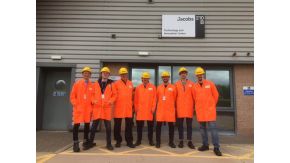
New home for swimming and scaffolding-building robots
The team behind one of Cumbria’s most innovative SMEs is opening up a world of opportunities since finding a new home in Jacobs, the international professional and technical services company.
Resolve Robotics, based in Cleator Moor, was established in 2019 and quickly built a reputation for developing novel technologies for robots to operate in challenging and hazardous environments.
Founder Andrew Ludar-Smith, who was brought up near Penrith, studied a Masters in Mechatronic Engineering - the study of systems that require a combination of mechanical, electronic and computer engineering - at Lancaster University and set up the company two years after leaving.
He and his colleagues joined Jacobs last summer under an asset purchase and staff transfer arrangement.
This included intellectual property for key technologies including MicroROV, a swimming robot designed for hostile environments, and the CellRail deployment system, which enables robots to build their own scaffolding-like structures in areas that humans cannot access.
The robots, some as small as a beverage can, remove the need for humans to work in hazardous conditions and improve safety by monitoring degradation, airborne contaminants and radiation levels in hard-to-reach locations. They also collect data to substantiate the case for asset life extension and allow inspection, maintenance and repair to be conducted on a wide range of assets using a single system.
Andrew, who is now Jacobs’ operations manager - robotics development, says: “Joining Jacobs has proved to be an ideal way for the team to fulfil its potential, enabling us to apply our knowledge and skills on projects in many new sectors and geographies.”
Andrew recently presented on Jacobs’ autonomous underwater robotics and asset inspection capabilities to the London Tech Bridge, a US-UK innovation accelerator which brings together both nation’s navies and their industrial suppliers.
He demonstrated how Jacobs’ robotic and autonomous systems save people from having to carry out inspections of shipboard fuel and ballast tanks, which often involve entry into confined and dangerous environments.
“It was great to see enthusiasm and interest in how our solutions can save on operational costs and reduce dry-dock time for naval ships,” he says.
Duncan Steel, Jacobs’ engineering development director, says: “We became interested in Andrew and his team because their robotic systems, wireless underwater communications and inspection technologies, supported by advanced instrumentation, custom electronics, innovative mechanical design and bespoke software, are applicable to a wide range of sectors where Jacobs already deploys robotic systems to support its work.
“We knew they had established an excellent reputation with leading UK organizations in the nuclear and infrastructure sectors and we saw the opportunity to introduce these technologies to new sectors and customers.”
CellRail, a modular deployment and retrieval system, is designed to reach any position and orientation within confined spaces and at heights to deploy tools and sensors. It can solve deployment challenges across multiple heavy industries, including rail and energy, and the system’s electronics and software gives Jacobs a world-leading capability to rapidly develop small and integrated robotic systems.
The team has also developed a wireless underwater communication technique, a mechanical hand for use inside gloveboxes, and an adaptable assembly system for automated manufacturing.
These applications complement Jacobs’s existing robotics capability.
Last year the company announced it had designed and built a robotic tool to retrieve sand-like debris from inside a damaged nuclear power reactor at Fukushima Daiichi in Japan. Jacobs also leads the European Remote Handling Alliance, which is designing robotic systems for ITER, the world’s largest fusion power experiment.
New home for swimming and scaffolding-building robots | In Cumbria (in-cumbria.com)
News by Category
- BECBC
- Cumbria
- Nuclear
- Social Value
- Professional Services
- Clean Energy
- Business
- People
- Government
- BECBC Member News
